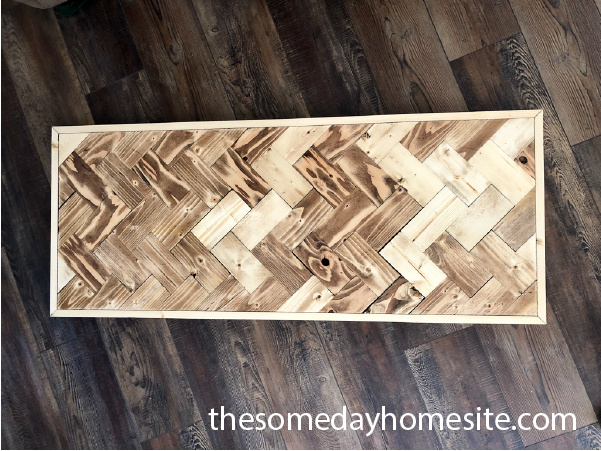DIY Herringbone Table Top
Ooooh man. This post has been a long time coming. I’ve been dreaming about a herringbone coffee table for my living room for a while but hadn’t quite figured out how I was going to do it. One week, Nate was out of town for a conference, so I decided to scour the garage and just go for it… and boy oh boy, I’m in love with this herringbone table top!
The best part of this herringbone table top is that it’s made almost entirely out of pine 2 x 4’s (ie: it’s super affordable). With the exception of a few pieces of scrap 1 x 4’s, this table top was built entirely out of cheap construction-grade studs. Now, I know pine isn’t exactly the finest choice for furniture building, but I’m a firm believer that #pineisfine, especially for my unfussy decor aesthetic. Also, I pretty much know my kids are gonna destroy just about anything I put in my home anyway, so for right now, the cheaper the better. Now that I’ve got one of these bad boys under my belt, I can always build another one out of a hardwood.
So, do you want to know how I did it? Grab a beer, because we’re gonna get into it.
DIY Herringbone Table Top
Supplies:
- Scrap 2 x 4’s (I wasn’t sure how big I was going to make my table top or even if my plan was going to work, so I used what I had and just cut a bunch of scrap wood up. I ended up with so many leftovers- which is fine because I plan to build two end tables the same way. For reference, I cut around 89 pieces at 6″ each and ended up with plenty of leftovers, which is fine since I plan to build matching end tables. For reference, this would be approx SIX 8′ 2 x 4 boards. Like I said, I used scraps rather than full boards, but I realize not everyone has the abundant scrap pile we do. #blessed #abundance #wegotwood ????)
- Elmer’s stainable wood glue
- Scrap 1 x 4’s (Again, this was scrap wood, dug out of our massively embarrassing garage pile. If I were to do this without scrap wood, I would purchase 2 8′ 1 x 4’s.)
- Wax paper
- 1.5″ brad nails
Tools:
- Planer (optional, but highly recommended. Construction lumber is known for being rough, twisted, and not always perfectly straight. A quick planing session before getting started can help ensure you’re working with smooth surfaces, free of any cupping.)
- 6-pack of Bud Light for your neighbor who lent you his planer (you can skip this one if you have your own planer, or keep it on the list and drink it yourself. After hours, of course.)
- Table saw
- Miter saw
- ALL OF THE CLAMPS
- Brad nailer
Building a DIY Herringbone Table Top
Before I cut any of my pieces, I ripped each 2 x 4 down on the table saw to give me a nice, perpendicular surface to adhere the pieces to. I took off approx 1/8-1/4″ from each side, effectively removing the rounding on each side. The goal is to get each 2 x 4 to exactly 3″ wide. Remember to measure EVERY time before you cut, and also remember that a 2 x 4 IS NOT actually 2″ by 4″.
I set the measurement at 3″ to take off the other rounded edge, then I set my saw to 3.25 to take off the first side of the board.


*For a quick reference on lumber dimensions, check out the handy chart I made with actual lumber dimensions.
Once I had all of my 2 x 4’s ripped down to 3″ wide, I ran each one through the planer on each side to make sure that every board was exactly the same width and to make sure I had a nice smooth top.
After I was done with that, I cut each board down to 6″ lengths on my miter saw. This took a long time and in hindsight, I wish I had set up a stop block to cut down on time spent measuring AND to ensure exact and complete accuracy with each cut. If I had a crosscut sled, I would have done these cuts on my table saw also, again, to ensure accuracy.
Once you’ve cut your billionth 6″ piece, take a little sandpaper to each block to remove any splinters from cutting. Cheap pine is notorious for making messy cuts, and honestly, the state of my miter saw blade probably didn’t help matters much. Luckily, I had two willing helpers for this step. I paid them each a nickel per block, so I’d say it worked out in my favor.
Now, you’re ready for the fun part!
Gluing up the Herringbone Pattern for the Table Top

I wasn’t sure how to make this next part happen- I googled “herringbone glue-ups,” “herringbone table top glue-ups,” and various forms of the same thing many times with no luck. It didn’t look like anyone had any advice for me on gluing up a herringbone pattern, so I had to figure it out on my own.
*there are plenty of methods online that will have you use a piece of plywood as a base and then either glue or nail your blocks to it in a herringbone pattern. I wanted to try gluing it up because I thought it might make for a better outcome.
I started by laying out my wax paper to keep the glue from dripping out of the boards and sticking to the table. It was easiest to glue up two pieces at a time, clamp them, and allow them to set for 30 min before moving on. I have a limited number of clamps (and I couldn’t find two of them at the time!), so this part took a LONG time. I squared the sets up with my metal square, and clamped them to a couple of boards I screwed to my table to create a 90 degree jig.

Once I had glued up 13 sets of two blocks, I decided I was happy with the length. I glued the 13 sets together, two sets (4 blocks) at a time. To get a solid bond with the glue, I used 4 strategically placed clamps.
Again, I waited 30 minutes before adding more glued up blocks.
Once I had the whole length glued up, I started gluing up more sets of two blocks so I could repeat the process again to add to the width of the table.
I considered gluing up the pairs into another length of 13 sets, but I wasn’t entirely sure that it would line up perfectly. Instead, I added the pieces two sets at a time (4 blocks at a time). I kept going in this pattern until I was happy with the length and the width.

Trim the sides

I used my circular saw to trim the jagged sides. I clamped my guide to create a guide to slide the metal guide of the circular saw along. Next, I used my metal square to make sure the sides were exactly square before cutting my short sides.

I set my table saw width to match the depth of the table top (approx. 1 3/8″, as I had taken some off of the surface in the planer). Once I had my fence secured, I ripped down my 1 x 4’s so I could use them to line the sides of the table. I liked the framed look, and I felt like this hid some of the raggedness on the ends. I mitered the corners and tacked them on with the brad nailer.

Finishing touches
I sanded the table top with 80 grit sandpaper to remove the areas where glue had squeezed out. Although I tried my best to line everything up, there was a little movement when I tightened the clamps, so I did have a few edges to sand down.
Next, I used a variation of my two-step stain process. I started off with Minwax Dark Walnut. After letting it dry completely (about a day), I hit it with 120 grit sandpaper. The goal wasn’t to take ALL of the stain off, but for the look I wanted for this project, I wanted to get most of it off. I wanted the dark stain to highlight the lines, knots, and any imperfections in the grain.
Next, I applied a coat of Minwax Early American. I like the lighter color of the stain, but the dark highlights from the Dark Walnut still peek through.

Normally, I would stop there, but I still wanted it to be a little lighter. I sanded it with 320 grit paper and ended up taking most of it off.
I finished it with 2 coats of my favorite wipe on poly, Minwax Wipe-On Poly in Clear Satin, sanding lightly between coats.

What I wish I had done differently…
Somewhere along the line, I must’ve cut a couple of pieces just a little too long. I didn’t realize this until I tried to glue all of it up, and by that time it was too late. I could’ve prevented this by using a stop block on my miter saw to create accurate cuts, or by using a cross sled on my table saw.
All mistakes aside, I’m still really happy with how it turned out.
Do you love herringbone? I would love to hear if you plan to make a herringbone table top, too!


